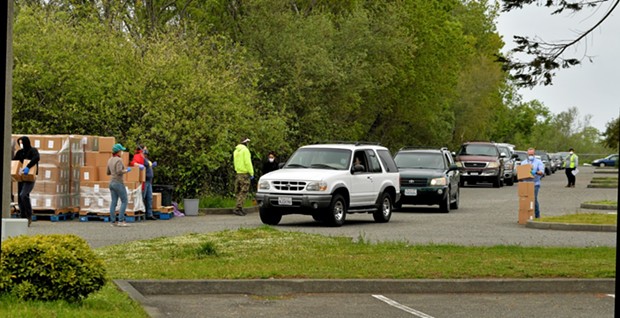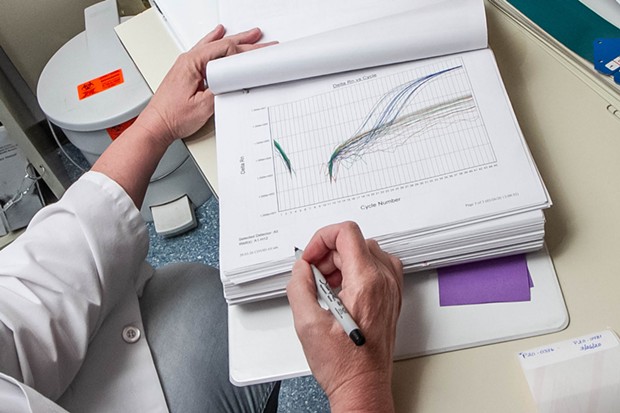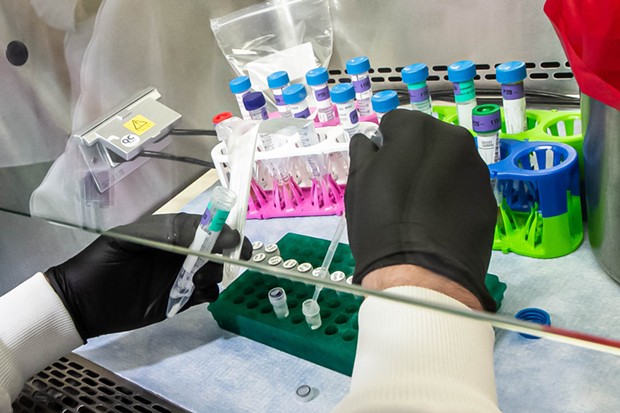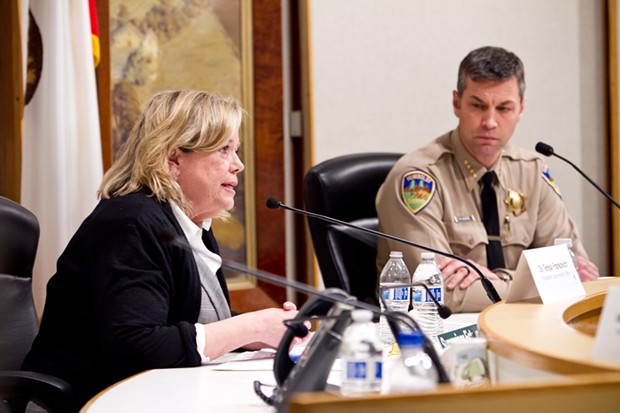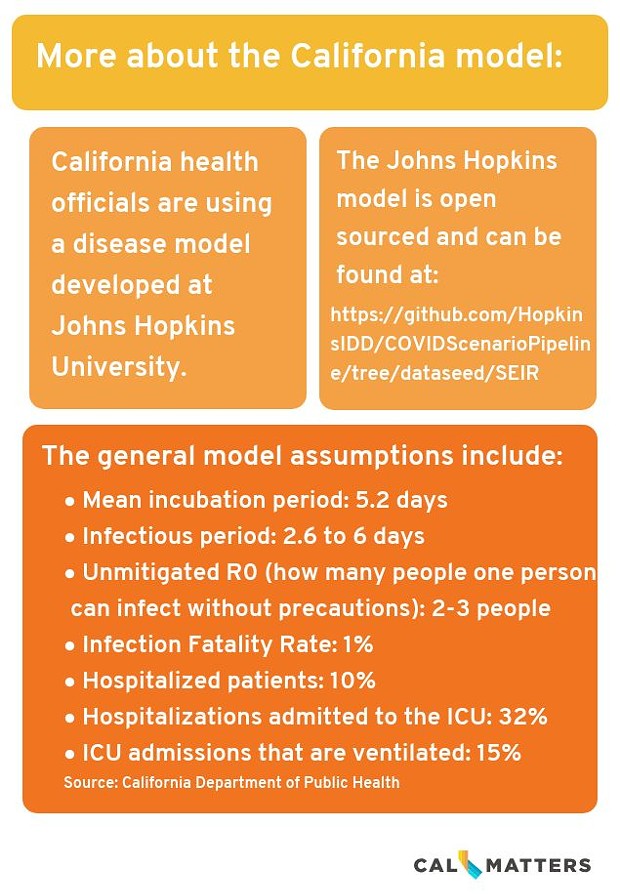Thursday, April 23, 2020
COVID-19 Losses Continue to Mount, with More than 2,100 HumCo Workers Laid Off
Posted By Thadeus Greenson on Thu, Apr 23, 2020 at 2:33 PM
Responding to a survey conducted by the Humboldt County Office of Emergency Services, 668 businesses have combined to report more than $28.3 million in lost revenue and the permanent loss of 2,130 jobs. Those numbers are up from two weeks ago, when 519 businesses reported 1,700 jobs lost and the loss of more than $21 million. At last report, 15 local businesses had been forced to close permanently as a result of COVID-19, though OES has since stopped publicly reporting the ongoing tally of closures.
According to data from the U.S. Census, 2,130 jobs lost would be a reduction of about 6 percent of Humboldt County's workforce, and that's with just about 21 percent of employers having responded to the survey. And even prior to COVID-19, 20 percent of Humboldt County households were living in poverty.
Statewide, California’s unemployment rate rose by 1.4 percent last month following the reported loss of almost 100,000 jobs, according to the Employment Development Department. But that was before the full weight of shelter-in-place orders was felt, and numbers have since skyrocketed, with one of every six Californians — nearly 3.4 million people — having since filed claims, according to a story in the Marin Independent Journal. According to the story, the state has paid out $3.94 billion in benefits since March 15, and that doesn’t include the latest batch of filings — some 530,000 people — last week, according to a report released today by the federal government. (While still a huge number, 530,000 is a steep reduction from the more than 1 million people who filed the week ending March 28.)
To file a claim, visit the EDD’s website here. The North Coast Small Business Development Center will also be hosting an online event tomorrow from 2 to 3:30 p.m. to offer information on how to get food assistance, financial aid and help finding a job for to those who have recently been laid off. Participants must register by 9 a.m. tomorrow by clicking here. And those needing food assistance can visit Food for People’s website here to learn about food distribution centers and pantries throughout the county.
The county urges business owners to fill out the OES economic impact survey here because it will help it assess countywide COVID-19 damage and losses, and potentially impact the amount of state or federal aid it can qualify for. OES also has a list of services for business owners and employees linked at its website here.
News Roundup: DA Will Prosecute 'Flagrant' Mask Order Violators, Dozens in Crescent City Protest Shelter Order (Without Masks)
Posted By North Coast Journal Staff on Thu, Apr 23, 2020 at 7:45 AM
Violating the order constitutes a misdemeanor offense, punishable by a fine of up to $1,000, 90 days in jail or both — with penalties potentially levied for each day someone is found to be in violation — but Fleming said she’s hoping she won’t need to prosecute anyone, reports the Times-Standard’s Sonia Waraich.
Wednesday, April 22, 2020
Public Health: No New Cases for Seventh Straight Day
Posted By Thadeus Greenson on Wed, Apr 22, 2020 at 5:03 PM
The announcement comes after the county recorded one positive case each on April 14 and April 15, the sole new cases locally since April 7, and a day after county officials announced both a mandatory facial covering ordinance and the first steps toward efforts to reopen aspects of life in Humboldt County that have been shuttered by COVID-19.
In a press release, Humboldt County Public Health Officer Teresa Frankovich attributed the county's recent span without a positive test to the countywide shelter-in-place order and social distancing recommendations.
“The success of social distancing emphasizes how powerful prevention strategies can be," she said. "Facial coverings are an important tool for us to have on board when we begin to ease shelter-in-place restrictions on businesses and services, and bring more people in the community into contact with each other.”
Today's results come after the Humboldt County Health Laboratory processed 41 tests and corporate labs returned another six results, for a total of 47. Testing rates have slowed in recent weeks, which has been attributed to everything from a backlog at corporate laboratories and a reluctance of providers to order tests to the county moving out of traditional cold and flu season and fewer people suffering respiratory illness symptoms unrelated to COVID-19. But locals have gone from seeing an average of almost 87 tests a day in the span from March 25 through April 7, to an average of 47 tests a day since, with the latter span coinciding with a slowdown in positive cases. The biggest decline has come from the corporate labs, which went from reporting an average of almost 45 tests results a day in the first span to just nine tests per day in the second.
Of the county's 52 cases to date, 50 patients have recovered fully under Centers for Disease Control and Prevention criteria and been released from isolation. Nine cases locally have been attributed to community transmission, meaning contact investigations could not determine the source of infection but believe it occurred locally.
Of the cases to date, nine of the patients have been located in Northern Humboldt County (meaning north of State Route 299), 40 have been in the "Greater Humboldt Bay Area" (meaning south of State Route 299 to State Route 36) and three have been in Southern Humboldt. (It's worth noting, however, the patients' areas of residence don't necessarily correlate with where they contracted the virus.)
Preguntas Comunes Acerca del Coronavirus
Posted By Jacqueline García, La Opinión on Wed, Apr 22, 2020 at 4:00 PM
Los síntomas más comunes de la enfermedad son fiebre, cansancio, tos seca y falta de respiración. La persona también puede experimentar molestias y dolores, congestión nasal, secreción nasal, dolor de garganta y / o diarrea.
En las situaciones más graves la persona comienza a sentir dificultad para
respirar. Estos síntomas pueden aparecer entre 2 a 14 días después de la exposición. Las personas pueden estar enfermas con el virus durante 1 a 14 días antes de desarrollar los síntomas.
Se estima que alrededor del 80% de las personas se recuperan de la enfermedad sin necesidad de un tratamiento especial, pero para algunas personas puede ser mortal.
2. ¿Cómo se trata el nuevo coronavirus?
No existe un tratamiento específico para la enfermedad causada por COVID-19. Sin embargo, muchos de los síntomas pueden tratarse. El tratamiento se basa en la condición del paciente.
Se estima que alrededor del 80% de las personas se recuperan de la enfermedad sin necesidad de un tratamiento especial. Actualmente no existe una vacuna para prevenir el nuevo coronavirus.
Update: Eureka City Council Approved Allowing Betty Chinn to Open Temporary Homeless Shelter for Women and Families
Posted By Iridian Casarez on Wed, Apr 22, 2020 at 1:09 PM
Update: The Eureka City Council unanimously approved a resolution Tuesday to add a retail building across the street from the Betty Kwan Chinn day center to its 2016 Shelter Crisis Declaration, paving the way for its conversion into a temporary shelter for women and families.
Before the shelter opens, the Betty Chinn Foundation must add another restroom and shower to the building. The foundation also has to change the entrance of the building to its C Street side, directly across the street from the foundation’s existing day center so as not to disturb other businesses on Seventh Street.
Chinn says she has to talk to her partners about funding before starting the renovations, adding that as of right now she doesn’t have enough money to proceed with the renovations.
Chinn and the city of Eureka are hoping the shelter opens next month, so families who impacted by the COVID-19 pandemic can have a safe place to stay.
Those in need of shelter can contact the Betty Kwan Chinn Day Center at 407-3833.
To make a donation to the Betty Kwan Chinn Foundation, visit the website here to donate online or mail a check to Betty Chinn’s Homeless Fund, P.O. Box 736, Eureka, CA 95502.
Previous: The Eureka City Council will consider adopting a resolution tomorrow that would expand the Shelter Crisis Declaration it enacted in 2016 to allow Betty Chinn to establish a temporary women and families shelter across the street from her day center at 205 Seventh St.
The retail building would be converted into a shelter to allow for “20 people in one bedroom assignments,” according to the staff report, and will be operated by the Betty Kwan Chinn Foundation.
Betty Chinn told the Journal that there are quite a few people who have come to her center looking for shelter as they have been impacted by the COVID-19 pandemic and have nowhere else to go. The new building, she said, would allow them to help people needing a place to stay.
“During this time, people need a safe place to stay, a safe place to be quarantined,” Chinn says. “I want to protect people as best as I can.”
Chinn says that her shelters take serious precautions when it comes to taking in new clients. She says that new residents for her shelters are quarantined for 14 days before they are able to roam the grounds freely, and that she also takes resident’s and staff’s temperature twice daily. If the new shelter is approved, she says she will be taking the same precautions there.
Clients would be able to stay in the shelter as long as they need to get back on their feet, she adds.
“The goal is for them to find permanent housing,” Chinn says. “So they will be able to stay for as long as they need to, to save money and learn to budget themselves for permanent housing.”
If approved by the council, the building will be converted “as soon as possible,” Chinn says adding that she hopes to open the shelter by May 1.
“[The building] is across the street from the day center so it will be easy,” she says. “If it doesn’t, I have to find a new building and new partners. I just hope this goes through.”
The Eureka City Council is also looking to adopt a COVID-19 Assistance Fund Grant Program that will allocate $50,000 in grants to Homeless Service Providers and $200,000 to support mortgage and rent assistance to households who are at 80 percent of area median income (those below 50 percent will be prioritized, the staff report states).
The Eureka City Council meeting will be held April 21, 2020, at 6 p.m. For more agenda items or to watch the virtual meeting remotely, visit the city website here.
Forever Homes Wanted: Shelters, Rescues Continue Adoptions During COVID-19 (With Video of Puppies!)
Posted By Kimberly Wear on Wed, Apr 22, 2020 at 11:24 AM
The process has changed a bit due to social distancing protocols but the Humboldt County Animal Shelter, the Sequoia Humane Society and Companion Animal Foundation are continuing adoptions by appointment, as well as placing cats and dogs in foster care.
To catch a sneak peek at some of the pets ready to play fetch or snuggle on a lap, visit each of their Facebook pages, here, here and here. (Online applications and more information can also be found at each of their respective websites.)
All three are also asking for community support to help continue their missions of keeping their charges as happy and comfortable as possible until someone comes to take them home.
Tuesday, April 21, 2020
Public Health: HumCo Still at 52 COVID Cases, Only Two Positives in Past Two Weeks
Posted By Thadeus Greenson on Tue, Apr 21, 2020 at 5:45 PM
The announcement comes after the county recorded one positive case each on April 14 and April 15, the sole new cases locally since April 7, and on the same day county officials announced both a mandatory facial covering ordinance and the first steps toward efforts to reopen aspects of life in Humboldt County that have been shuttered by COVID-19.
“With continued social distancing and mandatory facial covering, we can keep our community safe and prepare for what may lie ahead,” Humboldt County Public Health Officer Teresa Frankovich said in a press release.
Today's results — the first since Saturday — come after the Humboldt County Health Laboratory processed 40 tests and corporate labs returned another eight results.
Sheriff Calls on Government, Essential Businesses to 'Open Up' as Public Health Announces Mandatory Mask Order
Posted By Thadeus Greenson on Tue, Apr 21, 2020 at 5:04 PM
“Government needs to open up,” Honsal said in a video that was released this afternoon answering reporters’ questions about the local COVID-19 outbreak and the county’s resulting shelter-in-place order. “We need to lead by example.”
Within an hour of the release of the video, Humboldt County Public Health Officer Teresa Frankovich announced the issuance of an order that will take effect Friday and make it mandatory for everyone in Humboldt County to wear a facial covering at all times when in any indoor facility other than their home, in any enclosed areas or any outdoor space where individuals are unable to maintain at least 6 feet of physical distance from others at all times. Violations of the order constitute misdemeanor offenses punishable by imprisonment or a fine.
“Facial coverings are meant to protect the public from the user in case the user is infected and not yet displaying symptoms,” the order states. “Facial coverings used in conjunction with physical distancing of at least 6 feet and frequent hand washing may reduce the risk of transmission.”
In a press release announcing the order, Honsal calls the facial covering ordinance a "key step" in reopening the economy while "continuing to protect the members of our community from the virus."
The announcements come after the rate of confirmed infections in Humboldt County has slowed considerably in recent weeks, and currently sits at 52. The county hasn't confirmed a new case since April 15 and has only announced two since April 7.
In the roughly 11-minute video, Honsal pivoted from answering a reporter’s question about whether there’s been a rise in crime locally to speaking about economic pressures.
Monday, April 20, 2020
All But Five Local COVID Patients Have Recovered
Posted By Thadeus Greenson on Mon, Apr 20, 2020 at 5:44 PM
The email also notes that the Humboldt County Public Health Laboratory's daily test run started late today, so the county will be releasing results from today and tomorrow's test batches tomorrow afternoon. The confirmed case total remains at 52, as it has since Wednesday.
The email also addresses a Times-Standard story this afternoon that cited a California Health and Human Services database in reporting that another Humboldt County resident had tested positive for the virus. But the database also contained a host of other discrepancies from Humboldt County's Public Health's reporting, including total confirmed case numbers at various points in time, hospitalizations and patients under intensive care. In the email, Muller states that Public Health has been sent a number of dashboards from various organizations and agencies.
"Some of these portals appear legitimate, although almost all of them disagree with each other and with the numbers we have provided to you," she wrote to reporters. "We cannot explain information found on other people's websites. We can confirm that our own information is correct."
Finally, the email addresses rumors that a local Target employee has tested positive for COVID-19. This is true, Muller writes, but adds the employee did not work with customers and that Public Health has contacted their "close contacts," putting them under quarantine and monitoring. None have tested positive for the virus at this point.
"There is no evidence of contact exposure for members of the general public visiting the store," she wrote.
Predicting a Pandemic’s Path: What Models Can and Can’t Do
Posted By Barbara Feder Ostrov/CalMatters on Mon, Apr 20, 2020 at 4:11 PM
Underlying those visuals are disease forecasting models — complex mathematical algorithms that predict disease spread and severity based on different scenarios. Because they can help predict the effects of different interventions, including our social distancing, coronavirus pandemic models significantly influence how governments are responding.
It’s tempting to regard these models as oracles that can tell us precisely what to do and when to do it. Can they tell us when we should return to work, or when our kids can go back to school? Is Grandma safe in her nursing home or should she come home? When can businesses safely reopen?
As California’s COVID-19 caseload tops 30,000, state officials are using a model developed at Johns Hopkins University to aid in their planning. If you’ve watched Gov. Gavin Newsom’s daily briefings online, some of the charts shown are based on the model’s predictions.
But the models need to be fed reliable data, and some data is in short supply, especially without widespread U.S. testing for the novel coronavirus that causes COVID-19. We still don’t know how many people have been infected without symptoms, for example. Other inputs, such as incubation periods and death rates, change by the day as we learn more about this virus.
“What makes modeling especially challenging are the human factors. Individual behaviors, health care infrastructure and political response each can affect the outcome of an epidemic,” said Shweta Bansal, an associate professor of biology at Georgetown University who specializes in disease modeling. “I think of models as a call to action. They can tell us what happens if we don’t act and how we can prevent the most dire consequences.”
Here are five things you should know to make sense of infectious disease models:
Why are there so many COVID pandemic models — and why are they all so different?
There are different types of infectious disease models for different purposes. Each has limitations and each can be useful in its own way.
“SEIR” models, for example, involve equations based on the number of susceptible people (S) who can be infected, the number of people exposed (E), the number of people infected (I) and the number of people recovered(R). Agent-based models use massive computer power to simulate the actions of millions of hypothetical people to predict the spread of disease. Still other models examine a disease outbreak in one country and try to predict outcomes elsewhere in the world based on that data. Some models look at travel patterns in spreading disease, and still others assess how age, ethnicity and contributing illnesses may affect survival rates.
Epidemiologists say it helps to have more than one model in responding to disease outbreaks because they use different inputs. Combining results from multiple models can give a more nuanced picture of an outbreak’s trajectory.
“The fact that there are so many models is a healthy sign,” said Bansal. “It’s the same with weather forecasts that rely on multiple mathematical models. But unlike a weather forecast, with a disease forecast we have the ability to change the outcome.”
The White House has controversially used a model developed by the University of Washington’s Institute for Health Metrics and Evaluation, which some disease experts have criticized as being based on overly optimistic assumptions about the benefits of social distancing, among other statistical issues. The Imperial College London model, which predicted as many as 22 million U.S. deaths if no action was taken, also apparently prompted the Trump administration to issue tougher new social distancing guidelines.
What goes into making an epidemiological model for an infectious respiratory disease?
California and some other states use an SEIR model developed by Johns Hopkins University epidemiologist Dr. Justin Lessler. This coronavirus pandemic model, according to the California Department of Public Health, takes into account assumptions about how long the disease takes to incubate, how long people are infectious, how many people each patient can infect, the fatality rate, how many people need hospitalization or intensive care, and importantly for hospital planning, how many people need ventilators because they can’t breathe on their own.
The model assumes that NPIs – “non-pharmaceutical interventions” such as social distancing – started in the state March 20. In fact, some counties ordered residents to shelter in place earlier, some later.
California also has been faring better on a daily basis than this model’s predictions had forecasted — only 4,892 cases were reported on April 16, compared to 12,119 cases projected for that date. Assembly members set aside time at a budget hearing Monday to question the Newsom administration about the model and seek more details about its assumptions.
Rodger Butler, a spokesman for the California Health and Human Services Agency, cautioned that “there is considerable uncertainty” in the model’s predictions because we still don’t know enough about how the virus behaves and, without widespread testing, how many people are infected. “We are continuously refining our model with researchers and local public health offices,” Butler said.
Which raises the next question:
What happens if you don’t have enough data, or the right data?
This is what keeps public health experts up at night.
Because testing has lagged so badly in the United States, “right now we don’t know how many people are infected,” said Karin Michels, professor and chair of the epidemiology department at UCLA’s School of Public Health. “The biggest unknown (for disease models) is the denominator. How many people out of the infected are actually dying or wind up in the ICU? We have no idea at this point.”
Epidemiologists want to know more about when people are no longer infectious. They hope to learn more about who, once infected, is most likely to need hospitalization or a ventilator, to prevent overwhelming hospitals. True fatality rates aren’t one-size-fits-all; they will differ by age, gender, underlying illness and access to health care, among other factors.
Epidemiologists also need to better understand how many people might have been infected but not show symptoms. New antibody tests now being rolled out can help answer that question, but not quickly, and some of these tests are proving inaccurate. Some public health experts say that preventable delays in widespread testing and a perceived chaotic federal response have prevented the kind of critical data gathering needed to get a handle on outbreaks in various regions of the country — and to provide the kind of intelligence needed before reopening the country.
What makes a model succeed in its predictions?
Disease modelers and mathematicians argue about this a lot. The quality of the data that goes into a disease model is important. The range of error in the model’s predictions are important, too. If early predictions of a model don’t measure up to reality, its later predictions may not as well.
The University of Washington’s coronavirus pandemic model, for example, which aimed to predict outbreaks based primarily on early data from China and later Europe, has had such a wide range of error in its predicted death rates that some epidemiologists have recommended that governments do not use it for planning. The model’s predictions of when cases will peak in various regions also have swung dramatically in different weeks — and rarely coincided with other models’ forecasts, prompting some experts’ concern about the model’s validity going forward. Some politicians are citing the model’s relatively optimistic forecasts as justification to open the country earlier than public health officials recommend.
The model’s developers say they are continually updating their model and have adjusted it to reflect regional differences in how daily death rates peak over time, and how social distancing policies vary by region.
Still, disease models are supposed to serve as a wake-up call prompting us to act. If our actions succeed in slowing infections and deaths, making the predictions inaccurate — that’s a good thing.
What do public health experts wish people understood about coronavirus pandemic models?
Disease models are not perfect, and they can adapt as new data becomes available. Models “can help us think through different scenarios, but they shouldn’t be used as crystal balls,” Bansal said. “If we believe that a model’s prediction of 100,000 deaths is what will happen if we don’t act, then we do everything we can to prevent those 100,000 deaths.”
Also: they’re better for predicting short-term needs and outcomes, Michels said, such as how many ventilators a hospital might need next month, rather than next year:
“I don’t think we can predict the fall yet. We only know the virus will still be around, so life will be complicated.”
CalMatters.org is a nonprofit, nonpartisan media venture explaining California policies and politics.
